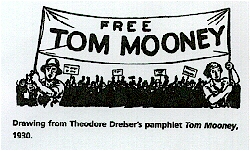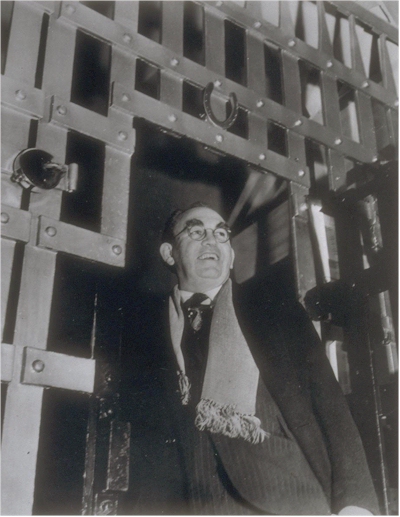
About Tom Mooney
Dan Georgakas
 Thomas J. Mooney (1892-1942) was the central figure in the most notorious labor
frame-up in the early half of the twentieth century. He and Warren K. Billings (1893-1972)
served twenty-three years (1916-1939) in California prisons for the death of ten persons
killed when a bomb exploded during the 1916 Preparedness Day Parade in San Francisco.
Mooney's actual offense was that he had been de facto leader of the left wing of the
California Federation of Labor and his activities had alarmed some of the most powerful
forces in the state. One of his closest associates was Warren Billings.
Thomas J. Mooney (1892-1942) was the central figure in the most notorious labor
frame-up in the early half of the twentieth century. He and Warren K. Billings (1893-1972)
served twenty-three years (1916-1939) in California prisons for the death of ten persons
killed when a bomb exploded during the 1916 Preparedness Day Parade in San Francisco.
Mooney's actual offense was that he had been de facto leader of the left wing of the
California Federation of Labor and his activities had alarmed some of the most powerful
forces in the state. One of his closest associates was Warren Billings.
Mooney had been raised in a Socialist family. At age fifteen, he won a contest
sponsored by a Socialist magazine and as his prize enjoyed a free trip to a conference of
the Second International in Switzerland. He would soon be an active national campaigner
for Eugene V. Debs and an ardent left-wing Socialist. He became editor of the journal Revolt
in 1912 and won  fame as a militant writer and speaker. He did not fear association with
anarchists and was not adverse to the doctrine of 'propaganda of the deed.' At one point
he was charged with dynamiting the property of the Pacific Gas and Electric Company in San
Francisco, but he was acquitted after three trials. By 1916 he was a dynamic force in San
Francisco labor circles. His two major interests that year were opposition to U.S.
participation in World War I and a drive to organize the car men of the United Railroads
of San Francisco. The bitter unionizing drive, although unsuccessful, took up most of his
energies that year as well as those of this wife, Rena, and Warren Billings.
fame as a militant writer and speaker. He did not fear association with
anarchists and was not adverse to the doctrine of 'propaganda of the deed.' At one point
he was charged with dynamiting the property of the Pacific Gas and Electric Company in San
Francisco, but he was acquitted after three trials. By 1916 he was a dynamic force in San
Francisco labor circles. His two major interests that year were opposition to U.S.
participation in World War I and a drive to organize the car men of the United Railroads
of San Francisco. The bitter unionizing drive, although unsuccessful, took up most of his
energies that year as well as those of this wife, Rena, and Warren Billings.
When the fatal bomb went off on 22 July, the Mooneys were blocks away, but both Tom and Rena, Warren K. Billings, Israel Weinberg, and Edward D. Noland were arrested for the deed. The common link was association with Tom Mooney. Billings, convicted previously for carrying dynamite on a passenger train, had a reputation for enjoying direct action. Weinberg was a jitney driver who occasionally chauffered the Mooneys, and his son was a pupil of Rena Mooney, who earned a living as a music teacher. Nolan was a Mooney backer in the trade unions. Ultimately only Tom Mooney and Warren Billings were convicted, Mooney for first-degree murder and Billings for second-degree murder.
In less than a year, solid evidence began to surface that the testimony against Mooney
and Billings had been perjured. Other evidence substantiated their own account of where
they had been. One of the investigating bodies was the federal Wickersham Commission,
composed mainly of conservatives. The commission concluded that the case's sole purpose
was to put Mooney and Billings behind bars. Even the trial judge and
jurors eventually made public statements that they had erred. National protests flooded
the statehouse, including a plea for mercy from President Woodrow Wilson. Mooney's death
sentence was commuted to life but no other relief was given. In the two decades that
followed, Mooney and Billings came to be viewed as labor martyrs. Their plight remained a
major concern of labor, civil libertarians, liberals, and radicals. But it was not until
1939 that Governor Culbert Olson released them. Mooney was officially pardoned at that
time, but Billings would not be formally pardoned until 1961.
behind bars. Even the trial judge and
jurors eventually made public statements that they had erred. National protests flooded
the statehouse, including a plea for mercy from President Woodrow Wilson. Mooney's death
sentence was commuted to life but no other relief was given. In the two decades that
followed, Mooney and Billings came to be viewed as labor martyrs. Their plight remained a
major concern of labor, civil libertarians, liberals, and radicals. But it was not until
1939 that Governor Culbert Olson released them. Mooney was officially pardoned at that
time, but Billings would not be formally pardoned until 1961.
Mooney tried to resume his activities but his health was gone. Eighteen months after his release, Mooney was bedridden, and on 6 March 1942 he died in San Francisco at age fifty. Billings went to work as a watchmaker after his release. He avoided radical politics but became vice president of the Watchmakers Union.
FURTHER READING
Frost, Richard H. The Mooney Case. Stanford, Calif.: Stanford University
Press, 1968.
Gentry, Curt. Frame-Up. New York: W. W. Norton, 1967.
Hunt, Henry Thomas. The Case of Thomas J. Mooney and Warren K. Billings. New
York. Da Capo Press, 1971.
Ward, Esolv Ethan. The Gentle Dynamiter. A Biography of Tom Mooney. Palo Alto,
Calif.: Ramparts, 1983.
OTHER RESOURCE
Mooney, Tom. Film (available at Tamiment Library, New York University) consisting of Mooney giving a résumé of his case, 1936.
from Encyclopedia of the American Left, Second Edition. Ed. Mari Jo Buhle, Paul Buhle, and Dan Georgakas. New York: Oxford University Press, 1998. Copyright © 1990, 1998 by Mari Jo Buhle, Paul Buhle, and Dan Georgakas.
Return to Lola Ridge